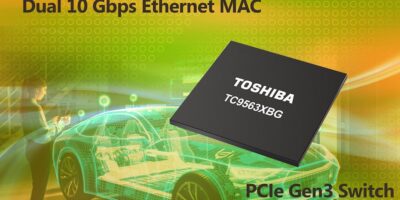Ethernet PCIe bridge IC anticipates zoning in automotive networks
Anticipating the movement towards zonal architecture in automotive design, Toshiba Electronics Europe has developed the TC9563XBG Ethernet bridge IC.
It incorporates two 10Gbits per second Ethernet media access controllers (MACs) supporting USXGMII (universal serial 10 Gbit media independent interface), XFI (the 10Gbit serial interface), the SGMII (serial Gbit media independent interface) and the RGMII (reduced Gigabit media independent interface) Ethernet interface standards.
Both ports support Ethernet IEEE802.1 audio/video bridging (AVB) for real time processing and low latency IEEE802.1 time sensitive networking (TSN) for synchronous processing. The ports also support single root I/O virtualisation (SR-IOV) on PCIe devices.
The IC is intended for use in automotive zonal-architecture, infotainment, telematics or gateways as well as industrial equipment. Toshiba said automotive networks are evolving toward zonal architecture that requires real time transmission between the zones using multi-gigabit Ethernet communication. It developed the TC9563XBG with dual 10Gbits per second AVB and TSN-capable Ethernet interfaces for this networking technology.
The TC9563XBG includes a PCIe Gen 3 switch with three external ports for communications with the host controller SoC and additional devices equipped with PCIe interfaces like 5G-modem modules. The PCIe switch upstream port supports up to four lanes (32G transfers per second) for connection with the host SoC. Depending on the configuration, the downstream ports can connect with one and two lanes to PCIe-capable devices.
As automotive communication requirements increase in terms of the amount of data as well as the required speeds, the bridge IC will support various automotive applications including in-vehicle infotainment (IVI) and telematics. It can also replace Toshiba’s Ethernet-to-PCIe TC9560 and TC9562 bridges, to upgrade system throughput and performance.
The use of PCIe interfaces has proliferated for device-to-device communication such as Wi-Fi, which can occupy PCIe interfaces on the host SoC. Using the TC9563XBG’s three-port PCIe switch function for these connections addresses this conflict.
Housed in a 10mm x 10mm, 0.65mm pitch P-FBGA package, the TC9563XBG bridge IC will be compliant with AEC-Q100 (Grade 3).
Samples are shipping now and volume production ramp-up will be in April 2022.




